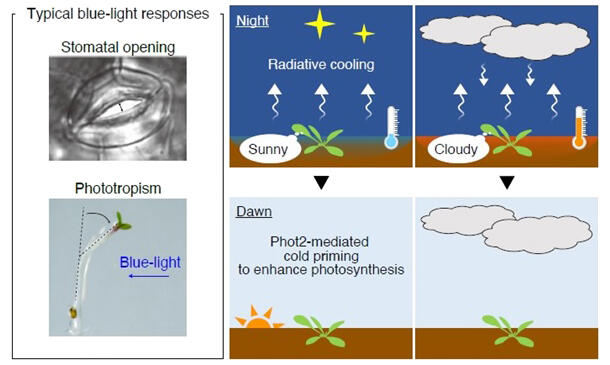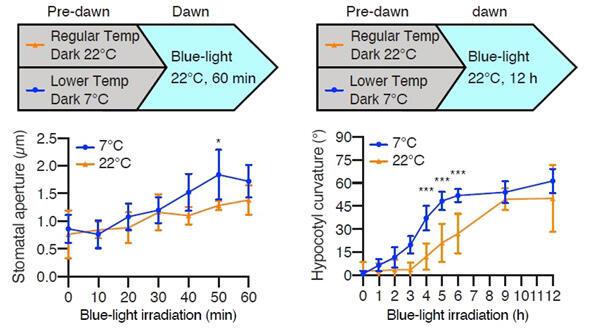A research group led by Professor Yutaka Kodama of the Center for Bioscience Research and Education at Utsunomiya University, in collaboration with Associate Professor Atsushi Takemiya of the Graduate School of Sciences and Technology for Innovation at Yamaguchi University, Professor Tatsuya Sakai of the Biology Program, Faculty of Science at Niigata University, and Professor Ken Haga of the Faculty of Fundamental Engineering at Nippon Institute of Technology has revealed plants' weather forecast-like function, in which plants use a sensor molecule to sense daily temperature decreases at night and predict sunlight intensity at dawn, promoting post-dawn photosynthetic responses. Phototropin 2 (phot2), a blue light and temperature sensor protein in plants, was found to sense low temperatures at night and promote blue light-induced responses at dawn. The results could be useful for improving agricultural productivity by regulating blue light responses and other purposes. The work was published in the Journal of Experimental Botany, an international journal, on January 30.

Provided by Utsunomiya University
Organisms have a mechanism called priming by which they adjust their physiological responses in advance of predictable environmental changes. Multiple sensors are utilized to sense the surrounding environmental conditions. Environmental factors that induce priming include light and temperature. Phototropins (phots) are blue light sensor proteins in plants that sense blue light to induce blue light responses, such as stomatal opening, phototropism, and chloroplast relocation. In 2017, the research group showed that phots also function as cold sensors in regulating chloroplast relocation. Sunlight contains light of various wavelengths, but the atmosphere limits the wavelengths of light reaching the ground in certain time frames of the day. Throughout the day, phots were expected to function most effectively at dawn because it is the time when blue light preferentially reaches the ground surface.

Provided by Utsunomiya University
In this study, the research group examined whether phots are involved in the plants' priming mechanism triggered by daily temperature changes. They used Arabidopsis (Arabidopsis thaliana) to analyze the effects of nighttime temperature on blue light responses at dawn. To investigate whether there is a temperature-dependent priming mechanism for blue light responses, they grew Arabidopsis in an environment that mimics dawn, at which phot activity is expected to be highest, and analyzed the effects of nighttime temperature on blue light responses at dawn.
The results showed that cold treatment in the dark prior to blue light irradiation promoted stomatal opening and phototropism. Next, they analyzed mutants deficient in phot1, phot2, or both, and found that phot2 is involved in cold-induced priming. These results indicate that phot2 also functions as a cold sensor for blue light responses other than chloroplast relocation. Furthermore, adding a 1-hour dark ambient temperature treatment after the dark cold treatment counteracted the cold-induced priming.
The time required for temperature sensing was also found to be about 1 minute. These findings indicate that the temperature just before dawn is important for cold-induced priming, and priming is reversibly controlled via temperature sensing by phot2. According to previous reports, a period of several days or longer was always required for cold-induced priming in plants. However, phot2-mediated cold sensing required less than 1 minute, and is considered a new environmental response mechanism with characteristics different from those previously known. Plants exhibit "cold-induced priming" presumably because air temperatures near the ground surface drop on clear nights due to radiative cooling.
Kodama said, "Utsunomiya has a large difference between daytime and nighttime temperatures, and this characteristic environment inspired this study. The students, staff in my laboratory, and collaborators made this study possible. We have proposed the hypothesis that many photoreceptors act as thermosensors in various organisms. I hope that our findings contribute to a better understanding of combined light and temperature environmental sensing in living organisms."
Journal Information
Publication: Journal of Experimental Botany
Title: Phototropin 2 mediates daily cold priming to promote light responses in Arabidopsis
DOI: 10.1093/jxb/eraf040
This article has been translated by JST with permission from The Science News Ltd. (https://sci-news.co.jp/). Unauthorized reproduction of the article and photographs is prohibited.




